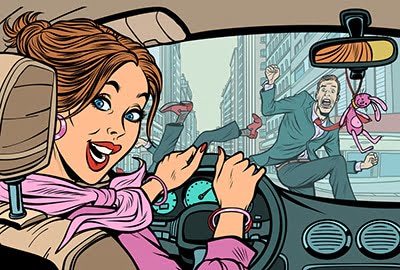How To Counter 5 Crucial Driving Emergencies
In driving schools, motorists are taught how to drive and park a vehicle while following the traffic rules and regulations. Nothing wrong with that but unforeseen driving emergencies present a different case of wit and instincts. For instance, to get a flying license, the pilot must demonstrate his ability to overcome basic emergency situations that could cause an accident if ignored. Even if you passed driving school with a distinction, ask yourself; when faced with an accident looming emergency, do I have the skills to survive? Remember, some of these things are not taught in driving school and lives could be on the line. However, with the necessary knowledge and practice, the chances could be in your favor.
Emergency 1: The Unforeseen Accident

Emergency 2: Invisible Motorcycles and Pedestrians
Quite often, accidents happen when a vehicle is turning or crossing an intersection. Most drivers involved will swear the motorcycle, pedestrian, or small car they collided with was invisible. But in most cases, it is the driver who was in a hurry to cross an intersection that they do not notice the victim. The most effective way to avoid hitting invisible motorcycles and pedestrians at the intersection is by observing the BLT (brake, look and turn). It seems obvious but it would save you a lot of emergency trouble. For a U-turn, look through the rear passenger window. Don’t take any chances when you’re driving straight either and a quick glance on the side before you cross an intersection will help you spot reckless drivers who skip the red light and stop sign.
Emergency 3: Traffic Panic
Imagine a big rig spilling in the middle of a highway, a herd of deer crossing the road in a rural highway, or a vehicle running out of fuel in the middle lane. If you’re on a busy highway, traffic panic of vehicles suddenly hitting the brakes is likely to happen and if you do not stop immediately, you risk crashing into whatever is ahead of you. How do you counter the emergency? Fortunately, most vehicles that were manufactured after 2012 are equipped with a computer-controlled anti-lock braking system which makes it easy to avert the crisis. All a driver needs to do is to step on the brake pedals like there is a million-dollar prize to be won. Remember not to finesse but to keep stomping the pedals until the vehicle stops. If there is an object ahead that can cause serious damage, steer clear of it. However, don’t make the mistake of stomping on the brakes first and steering afterward unless you want your car to swerve suddenly. That’s the reason why it is recommended for drivers to center the wheel before releasing the brakes.
Emergency 4: Blown out Tire
The sudden noise that follows a blown-out tire is almost similar to a shotgun blast. The obvious instincts reflex is to hit the brakes immediately and slow down. The most probable result is the vehicle swerving before crashing on the roadside. Instead, the best course of action would be to do the exact opposite by staying away from the brake pedal and continuing to press the accelerator for a few seconds. Do NOT panic. Keep driving straight in your lane. Eventually, the vehicle will slow down slowly due to the blown-out tire.
Emergency 5: Running off the Pavement/Road
Did you know that almost a quarter of single-automobiles accidents occur when the driver runs two wheels off the edge of the road? In a state of panic, the driver will likely over-correct causing the car to collide into oncoming traffic or swerve and flip on the highway. But if the drivers remain calm, such accidents could easily be averted. If you find yourself in such a predicament, get your foot off the accelerator and make sure the steering wheel is kept straight. After the vehicle slows down, steer the car back on the road. Remember to stay away from the brakes. The only exception for you to use ABS is if all 4 wheels are on the verge of running off the road. An impending collision with something ahead of you that will likely wreak havoc on your vehicle could also be a time to use ABS. But before you release the brakes, make sure you position the steering wheel at the center.
Of course, the foolproof way of surviving an accident is not getting involved in one. The first thing you have to adjust in your mind is accepting responsibility for everything you can control while you’re in the driver’s seat. That means forecasting an accident that is likely to happen and counter-reacting to the situation.
